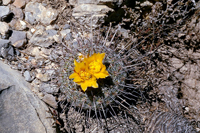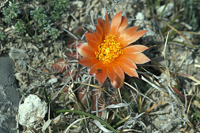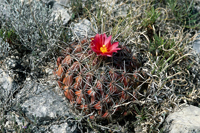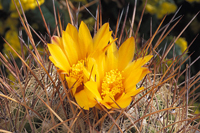Basionym: Thelocactus conothelos var. aurantiacus Glass & Foster, Cact. Succ. J. (US) 44: 48 (1972).
Type: About 9 miles east of La Escondida, 12 February 1971, Glass & Foster 3183 (ZSS 3532).
Synonyms: Torreycactus conothele var. aurantiacus (Glass & Foster) Doweld, Sukkulenty 1: 19 (1998). Torreycactus conothelos ssp. aurantiacus (Glass & Foster) Doweld, Sukkulenty 3: 36 (2000).
Description
Stem single, globose, 10 cm tall, 11 cm wide. Ribs indistinct. Tubercles conical. Areoles with glands. Central spines 4, 17-55 mm long, ochre to greyish, straight, acicular. Radial spines 8-23, 10-20 mm long, ochre to greyish, straight, acicular. Flowers 40-60 mm wide, yellow, orange or rarely almost red. Seeds 1.9 x 1.6 mm, testa cells conical with a smooth surface.
Distribution
Mexico, Nuevo León, Valley of Aramberri, occurring in matorral xerofilo on limestone hills, at elevations of about 1100 to 1600 metres above sea level. Its range lies within the Meseta Central subregion of the Chihuahuan Desert ecoregion.
Comments
Characteristic of this species are the deep yellow to orange or rarely almost red flowers, most unusual among Mexican cacti. The population near Aramberri is characterised also by its greater radial spine count, a trait that doesn't appear in the populations outside the Aramberri valley, where the plants has a phenotype identical to Thelocactus conothelos ssp. conothelos and only by the flower colour we can differentiate them. Deep orange to reddish flowers are rare and can be found in the population near Zaragoza, where they occasionally appear amid the yellow flowering plants.
Flowers can be expected at the end of winter.
Thelocactus conothelos ssp. aurantiacus (Glass & Foster) Glass, Ident. Guide Threatened Cacti of Mexico 1: TH/CON (1997).
 The holotype of Thelocactus conothelos var. aurantiacus Glass & Foster
The holotype of Thelocactus conothelos var. aurantiacus Glass & Foster
About 9 miles east of La Escondida, 12 February 1971, Glass & Foster 3183 (ZSS 3532).
enlarge
Image courtesy Zürich Sukkulenten-Sammlung.
 Thelocactus conothelos ssp. aurantiacus
Thelocactus conothelos ssp. aurantiacus
La Escondida, Nuevo León
Photo: A. Mosco
enlarge
 Thelocactus conothelos ssp. aurantiacus
Thelocactus conothelos ssp. aurantiacus
Zaragoza, Nuevo León
Photo: J. Jauernig
enlarge
 Thelocactus conothelos ssp. aurantiacus
Thelocactus conothelos ssp. aurantiacus
Zaragoza, Nuevo León
Photo: J. Jauernig
enlarge
 Thelocactus conothelos ssp. aurantiacus
Thelocactus conothelos ssp. aurantiacus
CSD 149 Marmolejo, Nuevo León
Photo: A. Mosco
enlarge